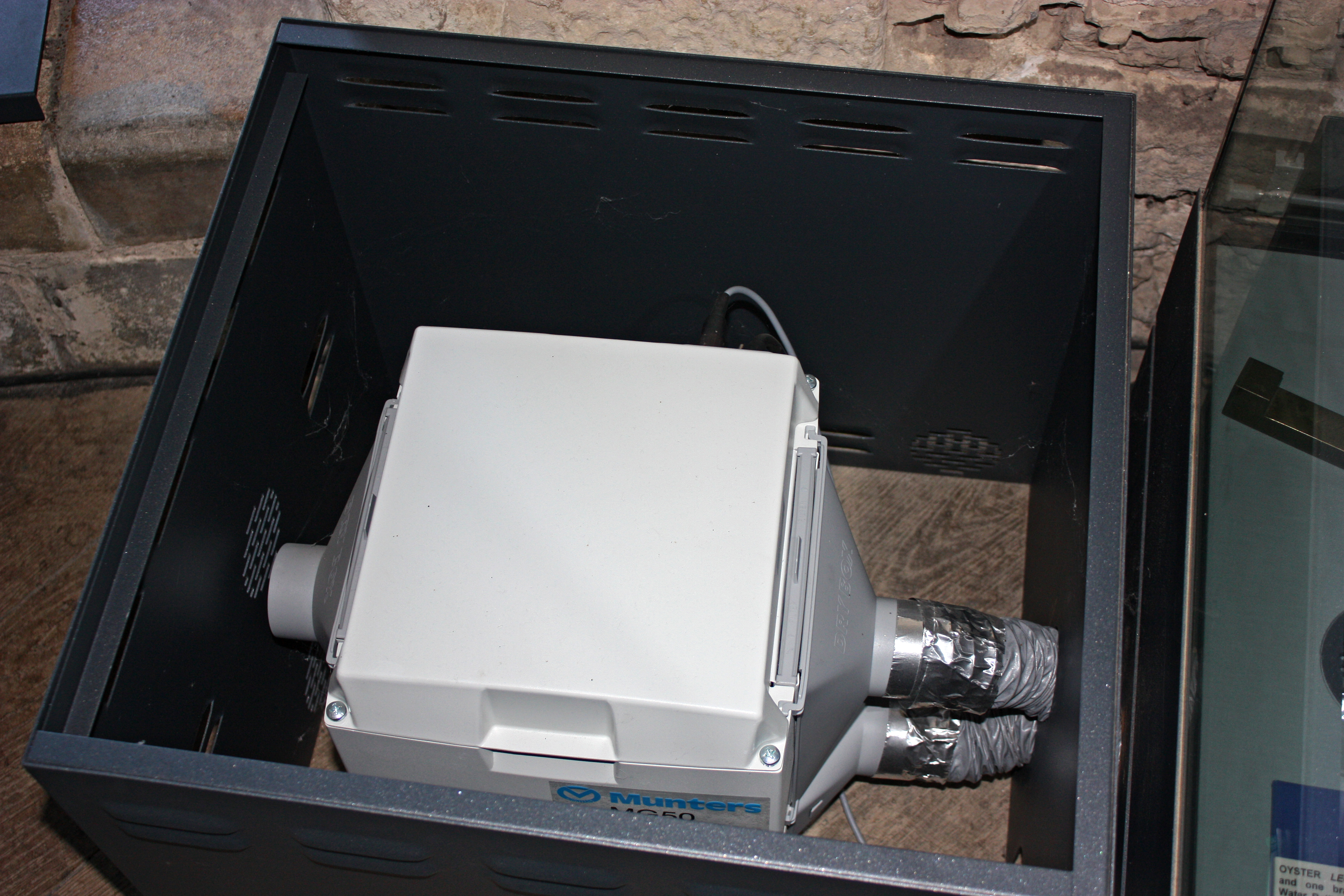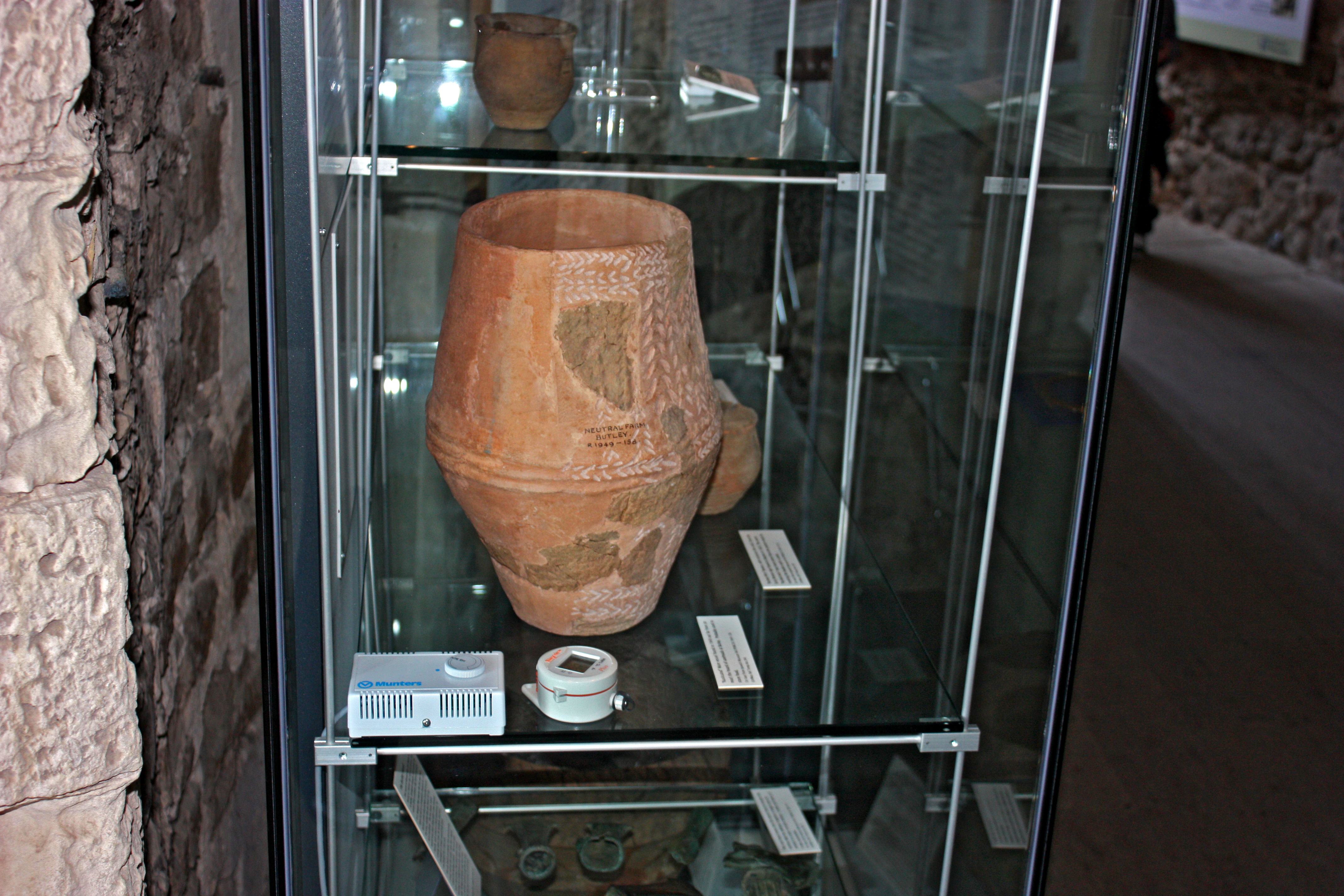Orford Museum is an accredited museum that collects and displays historical material found in Orford and the surrounding area in Suffolk. The museum is located inside Orford Castle, a historic local landmark that was built in the 12th century by King Henry II and is owned and maintained by English heritage. Inside the museum, display cabinets house material relating to the castle, the borough, archaeology – prehistory to 1550, river, land and sea, and the bronze age. Orford Castle offers the museum and its visitors a visually attractive home that is steeped in history. However, it is built from stone and unheated, providing very little protection against environmental damage for the exhibits. “Due to its age and the way it was built”, says Jennifer Hall, Orford Museum Curator“, a significant volume of moisture is absorbed by the building, especially in the winter when the cold temperatures cause condensation to build.” Without protection, the exhibits are exposed to potential moisture-related damage. This issue was no more apparent than when Orford Museum bid to bring a locally found Bronze Age hoard from Ipswich Museum to Orford.
Pikatiedot
- Preventing humidity damage such as corrosion and mold
- Ensuring consistent year-round climate conditions
- Providing precise & accurate control
- Compact & lightweight - easy to install and move
- Humidistats are clearly visible inside the cases, enabling easy monitoring
Conservation
To progress the bid, specific criteria including strict monitoring and control of relative humidity levels had to be achieved. Many metals corrode rapidly when condensation builds, with the rate of corrosion further accelerated by natural and industrial pollutants. If exposed to high humidity, bronze can develop “bronze disease,” an irreversible corrosion process that will destroy the artefacts if they are not properly protected. To ensure that required conditions could be achieved, Orford Museum consulted English Heritage, the Victoria & Albert Museum and the Museum of London for advice. They recommended Munters, a global leader in energy-efficient air treatment and dehumidification.
The Munters solution
Thanks to Munters, Orford Museum was able to reassure Colchester and Ipswich Museum Service that relative humidity levels would be consistently maintained below 50% RH, therefore securing a long-term loan of The Bronze Age exhibits. Orford Museum first purchased one MG50 desiccant dehumidifier for Case 3, The archaeology collection. The MG50 desiccant dehumidifier is a compact, lightweight unit that is well suited for smaller spaces. At the heart of the dehumidifier lies Munters desiccant rotor (wheel), a simple yet genius principle designed by Carl Munters more than 60 years ago. Two air streams pass simultaneously through the slowly rotating rotor that is treated with a highly effective desiccant. One air stream is dehumidified to provide the necessary dry air, the other dries the rotor, exhausting the accumulated moisture externally. Dry air protects Bronze Age exhibits With the MG50 having proved beneficial to the artefacts in Case 3, Orford Museum raised funds to purchase a further four MG50 dehumidifiers, resulting in all five of the upright cases being monitored, protecting, and conserving the collections in the museum. The museum is now supplying dry air to protect artefacts including leather money bags, metal badges, coins and even a medieval metal cross bow. Like metal items, the condition and lifetime of items such as paper, photographs and leather is significantly increased by preventing moisture damage such as mold and fungal growth. Inside each display case, Munters humidistats constantly monitor conditions, automatically turning the dehumidifiers on and off as needed. This ensures humidity levels are maintained consistently day and night all year round, while also maximizing energy efficiency. Aesthetics were also an important consideration for the Museum. Minimizing any impact on the museum and visitor experience was essential, and there could be no impact on Orford Castle itself as it is protected and owned by English Heritage. One of the benefits of the MG50 dehumidifier is that it does not need to be fitted on a wall, it is easy to move around and is small enough that it does not obstruct the view of the display cases for visitors. Each MG50 dehumidifier has been placed inside a specially-designed small metal box next to each display case and supplies dry air through minimal pipe work. As part of the conditions for the loan of The Bronze Age exhibits, Orford Museum are to ensure that the display case is opened very rarely, and regular reports on climate conditions are to be supplied to the Curatorial Advisor at Colchester and Ipswich Museum Service. To achieve this, the humidistats that are fitted inside each case are made clearly visible to the Curator to ease the process of taking humidity readings and prevent unnecessarily opening the cases. Munters helps bring unique collection home to Orford Orford Museum is in the upper hall of Orford Castle, which is accessible from a wide, but very irregular, stone newel staircase. Choosing a compact, lightweight dehumidifier enabled quick and easy installation and offers flexibility to move the unit to another part of the museum in the future if desired. Michael Flint, Chairman of the Orford Museum says, “The Bronze Age exhibits are an exciting addition to the museum and without Munters it would not have been possible to bring this unique collection home to Orford.” Munters have installed climate control in over 2000 museums worldwide. To read other successful museum and archive case studies, visit www.munters.co.uk/preserve
Pikatiedot
- Preventing humidity damage such as corrosion and mold
- Ensuring consistent year-round climate conditions
- Providing precise & accurate control
- Compact & lightweight - easy to install and move
- Humidistats are clearly visible inside the cases, enabling easy monitoring




